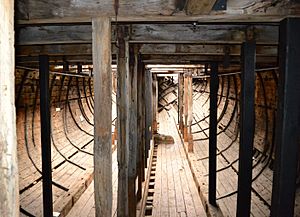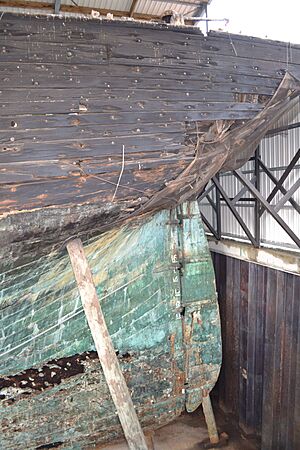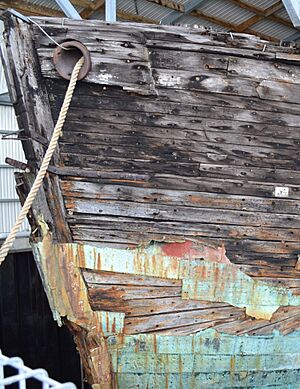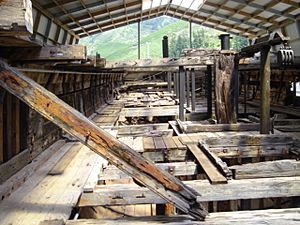Edwin Fox facts for kids

Interior of hull of Edwin Fox, on display at Picton, New Zealand
|
|
Quick facts for kids History |
|
|---|---|
| Name | Edwin Fox |
| Owner |
|
| Port of registry | Southampton |
| Builder | William Henry Foster, Calcutta |
| In service |
|
| Out of service | 1950 |
| Fate | Sold, 1965 |
| Status | Museum ship |
| General characteristics (as built) | |
| Type | East Indiaman |
| Tons burthen | 836 (bm) |
| Length | 157 ft (47.9 m) o/a |
| Beam | 29 ft 8 in (9.0 m) |
| Draught | 23 ft 6 in (7.2 m) |
| Sail plan | Full-rigged ship |
The Edwin Fox is one of the oldest merchant sailing ships still existing today. It is also the only ship left that carried people who were sent away as punishment to Australia. This ship is special because it is the "only complete hull of a wooden deep-water sailing ship built to British standards" that survives outside the Falkland Islands.
The Edwin Fox carried new settlers to both Australia and New Zealand. It also transported soldiers during the Crimean War. Today, you can see the ship in a dry dock at The Edwin Fox Maritime Centre in Picton, New Zealand.
Contents
The Edwin Fox's Early Journeys
The Edwin Fox was built in Calcutta in 1853. It was made from strong teak wood. Its first trip was to London, sailing around the Cape of Good Hope. After that, it became a troop ship during the Crimean War. It later carried passengers and goods.
On February 14, 1856, the ship made its first journey to Melbourne, Australia, with passengers. Then, it sailed between different ports in China for trade. In 1858, the British Government hired it to carry people who were sent away as punishment to Fremantle, Western Australia.
Carrying New Settlers
In 1867, the Edwin Fox was changed from a full-rigged ship to a barque. A barque has a different type of sail arrangement. From 1873, it began carrying new settlers to New Zealand. It made four trips, bringing 751 people to their new home.
The journey lasted about three months and was very tough. Passengers could only bring a small amount of luggage. Sadly, some people did not survive the long trip. When they arrived, conditions were often harder than they expected. Many settlers also felt cut off from their families in distant Europe.
From Lamb to Coal
As steam-powered ships became popular, the Edwin Fox's time as a sailing ship ended. In the 1880s, it was changed into a floating freezer. This was for New Zealand's growing sheep industry, which needed to keep lamb meat cold. The ship was towed to Picton in the South Island on January 12, 1897.
It continued as a freezer ship for a while. Then, in 1905, it was changed again into a coal storage ship. By this time, it had lost its masts and sails. Holes were cut in its sides, and most of its inside parts were removed. The ship was used until 1950. After that, it was left to slowly fall apart at its dock.
Saving a Piece of History
In 1965, the Edwin Fox Society bought the ship for a very small price. In 1967, it was moved to Shakespeare Bay, where it stayed for 20 years. After raising a lot of money, the ship was floated again. It was then towed to its final home, a dry dock on the Picton waterfront. The ship was floated into the dock, and the water was drained to start its preservation.
In 2013, the Edwin Fox Society received a special award. It was a World Ship Trust Award for their work in saving the ship. At first, there were plans to fully restore the ship, including its sails and inside areas. However, this was found to be too difficult and expensive. It was also hard to find the right wood.
So, the ship is now preserved as a hull (the main body of the ship). There is also a museum next to it with lots of information. Visitors can explore two of its decks. In 2015, the Marlborough Heritage Trust took over the ship and museum. This helps make sure the Edwin Fox is protected for future generations.
A book called Teak and Tide was published in 2014. In 2015, the BBC show Coast filmed a story about the ship for its New Zealand series. In 2016, the ship was scanned in 3D. This recorded its exact size and shape. People hope to create a virtual version of the ship someday.
Between 2016 and 2021, the ship was studied as part of a larger project. This project looked at British colonial-built ships from the late 1700s to mid-1800s. The Edwin Fox has been given a special Category I registration by Heritage New Zealand. This means it is a very important historical place. The Marlborough District Council now helps manage the Edwin Fox. They are working to keep it well-maintained and preserved.
See also
- Thomas Bushell, a person who traveled on Edwin Fox
- Convict era of Western Australia
- List of convict ship voyages to Western Australia
- List of museum ships




